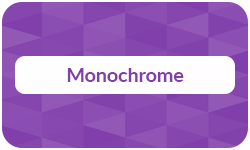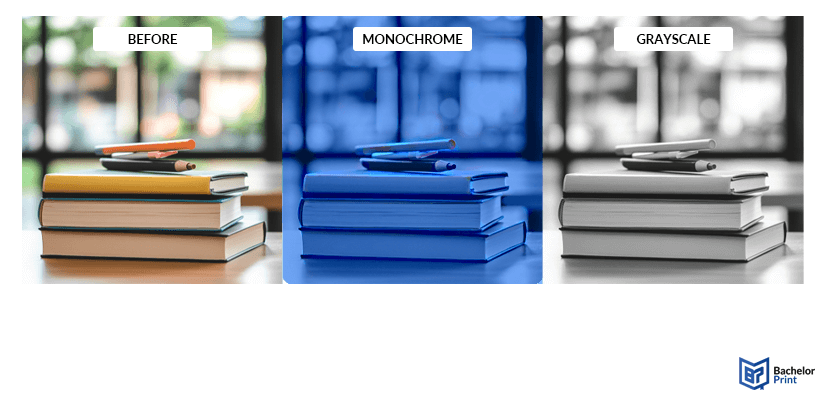
Much like the vivid imagery in BABYMETAL’s Monochrome, where the night sky is imagined in vibrant colors despite its inherent darkness, monochrome printing brings clarity and focus to every detail, stripping away distractions. It’s a powerful tool that, though limited to a single color, opens up endless possibilities for artistic expression, professional communication, and high-impact design.
Definition: Monochrome
The printing term monochrome refers to single-color printing, typically using black printing ink or toner cartridges on a white background. While it often implies black and white, it can also involve any single color in certain applications.
Distinction from:
Black and white printing
Uses only pure black and white tones
Grayscale printing
Varying shades of gray to simulate full color
Color printing
Combination of different colors, typically CMYK color model
Note: We will explore the specific differences between monochrome vs. grayscale printing in this article, so be sure to keep reading.
Monochrome printing is commonly used across technologies like laser printing, digital printing, and offset printing, making it a versatile and cost-effective option for many printing needs.
Print black & white copies online for AU$0.16
- Print black & white copies in bulk or in small quantities
- Affordable single- & double-sided black and white copies
- Professional printing service for individual solutions or printouts
Learn more!
Common uses
Monochrome printing is highly versatile, serving various purposes across different industries. Below are some of the most common uses:
Monochrome printing is perfect for large print runs of educational content, ensuring legibility without the extra cost of color.
Many artists and photographers prefer monochrome prints for their simplicity and timeless quality.
Monochrome is ideal for business communications, providing a professional look while being cost-effective for high-volume printing.
Monochrome printing offers high contrast and legibility, making it perfect for shipping labels. Using a label printer ensures clear, easy-to-read barcodes and text.
For technical industries, monochrome printing guarantees precision and clarity, particularly when fine details are essential for accuracy and readability.
Benefits
Monochrome printing offers several key advantages:
Benefits
- Eco-friendly: Reduced ink/toner usage and less waste.
- Faster turnaround: Quicker printing speeds, especially with laser printers.
- Better readability: High contrast between text and background ensures clarity.
- Cost-effective: Less toner or ink is used, making it affordable for large print jobs.
Challenges
While monochrome printing offers several benefits, it also comes with some challenges:
Challenges
- Less visual impact: Lacks the vibrancy of color prints.
- Image quality: Detailed images may lose depth or clarity.
- Limited design options: Only one color, which limits creative flexibility.
- Not suitable for all content: Some projects need color for better presentation.
Technology
Monochrome printing involves using a single color, typically black, across various technologies to produce clear, efficient, and cost-effective prints.
Laser printers
Laser printers are commonly used for monochrome printing, utilizing black toner to produce sharp, clear text and graphics. These types of printers use a laser beam to transfer toner onto paper, making them fast, efficient, and ideal for high-volume printing. They are often preferred for business documents, invoices, and reports due to their speed and low cost per page.
Inkjet printers
Inkjet printers designed for monochrome printing typically rely on only the black ink cartridge. These printers spray tiny droplets of ink onto paper to create text and images. While slower than laser printers, inkjet printers are more versatile, capable of printing on a variety of paper types and producing high-quality prints for photos and graphics.
Preparing files
When preparing files for monochrome printing, it’s important to ensure that the black is set to 100% K (Key) in the CMYK color model. Using RGB black can result in a less sharp and more inconsistent print, as RGB black isn’t pure enough for clear monochrome results.
Color files printed in monochrome
When color files (e.g., RGB or CMYK images) are printed in monochrome, the printer converts the colors to shades of gray. This can sometimes result in a loss of depth, detail, or contrast, so it’s important to adjust images beforehand to maintain clarity in monochrome.
Monochrome vs. grayscale printing
Monochrome and grayscale printing are often confused, but they have key differences in how they handle color and shading. Here’s a simple comparison:
Monochrome printing
Grayscale printing
Uses
Color
Uses hues of a single color
Uses varying shades of gray
Shading
No shades
Shades of gray
Preparation
Use pure black (100% K) in CMYK
Images converted to shades of gray
Image quality
Limited to solid colors, no gradients
Can show smooth transitions and more detail
To help visualize the difference, the image below shows the same motif in its original color, in monochrome, and in grayscale.

Tips for printing
To ensure top-quality monochrome prints, start by using 100% K (black) in the CMYK color model for text and vector graphics. These guarantees crisp lines and strong contrast. Avoid relying on auto-conversion when changing color images to grayscale—it’s best to manually optimize them to retain as much detail as possible.
Choosing the right printer paper is also essential; white, smooth, or satin printer paper types will provide the sharpest output. Finally, be sure to double-check the contrast and detail of logos during the prepress stage, ensuring they are clear and well-defined before printing.
Printing services at BachelorPrint
- Individual solutions & personal support
- High print quality & fast production times
- Wide range of print products for every need
Learn more!
FAQs
A monochrome color refers to a color scheme that uses variations of one hue, often in different shades or tints.
Yes, monochrome refers to using a single color in various shades, typically black or a single other color.
Monochrome printing uses only one color (usually black) to print text or images, often on a white background.
It depends on the need. Monochrome is ideal for text-heavy documents, while grayscale is better for images with subtle shading and more detail.
Yes, monochrome prints require ink or toner, typically black, to create the printed output.